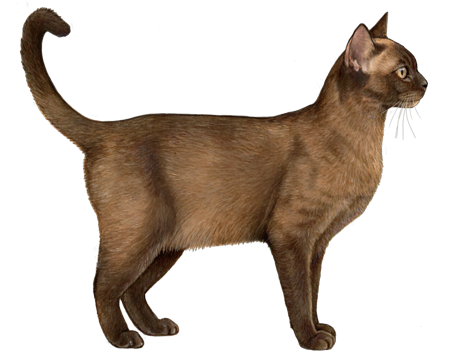
Bombay
Bombays may look like (tiny) black panthers. But they're teddy bears at heart. Their fun-loving, cuddly, mischievous nature makes them excellent—and entertaining—members of the family.
Interested in discovering if your cat is a Bombay?
Check out Wisdom Panel's DNA test.
Bombay Traits
General Appearance
The Bombay is an alert cat with a solid, well-balanced body and sweet facial expression. They have a muscular build and surprising weight for their medium size.
Coat and Coloring
Bombays have a short, close-lying coat that accentuates their muscular form. Their hair is fine with a satin-like texture and high-gloss sheen. The color is a deep, dense black from the root to the tip.
Distinctive Physical Traits
Bombays have a rounded head with no sharp angles and a short muzzle. Their medium-sized, wide-set ears tilt slightly forward, creating an alert appearance. And their large, round eyes come in shades of gold and copper—resembling new pennies.
Bombay Temperament
The Bombay inherited personality traits from its founding breeds: the laid-back American Shorthair and the curious, social Burmese.
Don't expect a lot of alone time when you have this people-oriented breed. Because they love being around humans, Bombays are often underfoot or on a lap. They get along well with other pets and are exceptionally good with kids—making them an ideal addition for most families. Of course, their desire for companionship means they don't enjoy being alone for long periods. So, if you're often away from the house for hours at a time, consider getting them a feline "sibling."
Bombays are playful cats that love interactive toys and games of fetch. They can also be leash trained.
Bombay History
Based on the breed's name, you might assume these cats originated in India. But in truth, Nikkie Horner began developing the breed in Louisville, Kentucky, in 1953. Though India wasn't the birthplace of the Bombay, it was the inspiration for the breed.
Horner hoped to create a cat that resembled the small black panthers found in India. To achieve this, she began crossing black American Shorthairs with Burmese. Her initial efforts were unsuccessful, but in 1965, she finally prevailed.
Cat associations began accepting the Bombay for championship competition in the 1970s. Though these cats are relatively rare, those familiar with them are captivated by their sleek, jet-black coat and stunning copper eyes.
Bombay Care
Nutrition
Bombays require a high-quality diet. Because nutritional needs vary for kittens, adults, and senior cats, opt for a formula that's age-appropriate for your pet.
To keep your cat at a healthy weight, measure out meals and reduce portions if necessary. And don't forget to account for calories from treats in their daily totals. As a guideline, treats should make up no more than 10% of a cat's calories.
Finally, all cats need access to fresh, clean water around the clock.
Grooming
The Bombay's short, sleek coat is a breeze to maintain. The occasional once-over with a rubber brush is typically all that's needed to remove loose fur and keep them looking their best.
Most cats' nails require monthly trimming to prevent them from getting too long. Long nails are more likely to snag on something and become torn or damaged. They can even grow into your cat's paw pads, leading to pain or infection. In addition to clipping, providing a scratching post will allow your cat to do some nail maintenance themselves (thanks to their instinct to scratch).
Dental hygiene is another essential component of your cat's care. Starting during kittenhood, your Bombay should follow a routine that includes at-home teeth brushing combined with regular visits to the veterinarian for professional dental cleanings and exams.
Health
Because of their short nose and muzzle, Bombays may be more likely to have respiratory issues or experience excessive tearing. They may also be more prone to developing Hypertrophic Cardiomyopathy, which decreases the heart's efficiency and can lead to other problems. Talk with your veterinarian about ways you can manage or minimize the health risks of your cat.
Bombay Genetic Health Conditions
-
Burmese Head Defect (Discovered in the Burmese)
Burmese Head Defect causes severe facial defects when two copies of the variant are present, and affected cats require humane euthanasia shortly after birth.
-
Familial Episodic Hypokalemic Polymyopathy (Discovered in the Burmese)
Familial Episodic Hypokalemic Polymyopathy causes episodes of muscle weakness and pain.
With more than 45 health tests, Wisdom Panel™ Complete for Cats screens for these and other important genetic conditions—allowing you to better plan for your cat's lifelong care.
Breed Group
Asian
The Asian Group is comprised mainly of genetically similar breeds which vary widely in traits and personalities. These breeds are distinct from those of the Siamese and Oriental Group.













